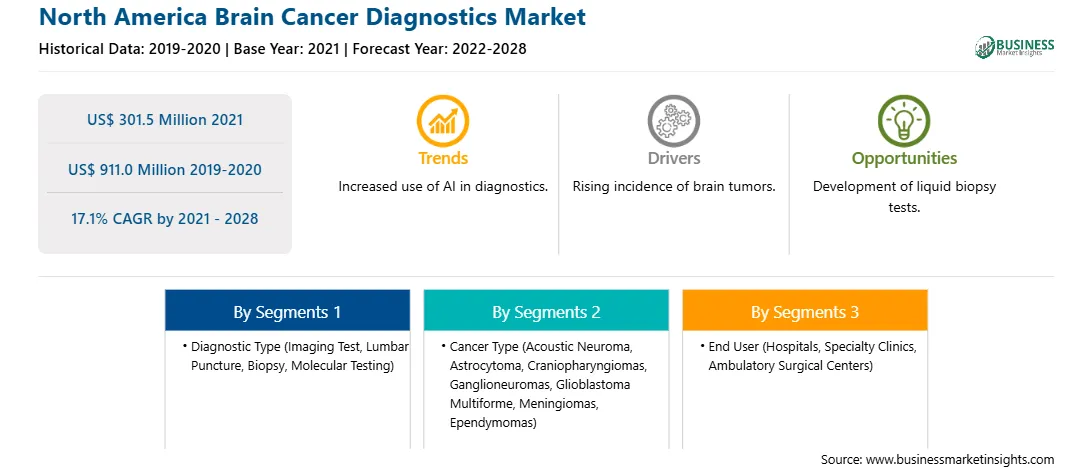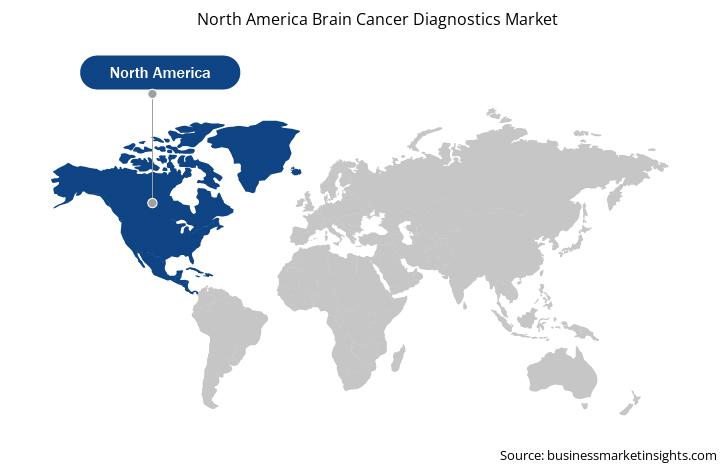Brain cancers are caused due to extracellular growth of the cells in the brain that causes tumors. The tumor includes primary brain tumors and secondary brain tumors. Primary brain tumors are formed in the brain and do not spread to other body parts, whereas secondary tumors, also known as metastases, are those cancers that began in another part of the body. Brain tumors are categorized into 40 major types that are further classified into two major groups, including benign, i.e., slow-growing and have less possibility to spread, and malignant, i.e., cancerous, and more likely to spread.
Thus, the increase in prevalence of brain cancer is expected to create a significant demand for brain cancer diagnostics in the coming years, which is further anticipated to drive the brain cancer diagnostics market.
The COVID-19 pandemic has disrupted healthcare systems, leading to concerns about its subsequent impact on non-COVID disease conditions. Cancer diagnosis and treatment are time-sensitive and are likely to be significantly affected by these conditions. The activities of each cancer discipline have been adversely affected by the COVID-19 pandemic. In addition, childhood malignant brain tumors are characterized by rapid growth and require early diagnosis and appropriate treatment. Therefore, delaying or modifying treatment can compromise its effectiveness and reduce patient survival. Flores et al. reported that delayed diagnosis of brain tumors is correlated with a worse prognosis. A prolonged pre-diagnostic symptomatic interval has negative and severe consequences, such as death or serious brain damage following the increase in intracranial pressure. Due to the fear and pressure of SARS CoV2 infection, changes in the decision-making process of children with brain tumors may have a negative impact on their final outcome. Never have multidisciplinary tumor boards serve a crucial role during the current COVID-19 outbreak. All pediatric cases diagnosed with a new brain tumor should be discussed in the multidisciplinary tumor board to determine the best treatment plan for each child.

Strategic insights for the North America Brain Cancer Diagnostics provides data-driven analysis of the industry landscape, including current trends, key players, and regional nuances. These insights offer actionable recommendations, enabling readers to differentiate themselves from competitors by identifying untapped segments or developing unique value propositions. Leveraging data analytics, these insights help industry players anticipate the market shifts, whether investors, manufacturers, or other stakeholders. A future-oriented perspective is essential, helping stakeholders anticipate market shifts and position themselves for long-term success in this dynamic region. Ultimately, effective strategic insights empower readers to make informed decisions that drive profitability and achieve their business objectives within the market.

| Report Attribute | Details |
|---|---|
| Market size in 2021 | US$ 301.5 Million |
| Market Size by 2028 | US$ 911.0 Million |
| Global CAGR (2021 - 2028) | 17.1% |
| Historical Data | 2019-2020 |
| Forecast period | 2022-2028 |
| Segments Covered |
By Diagnostic Type
|
| Regions and Countries Covered | North America
|
| Market leaders and key company profiles |
The geographic scope of the North America Brain Cancer Diagnostics refers to the specific areas in which a business operates and competes. Understanding local distinctions, such as diverse consumer preferences (e.g., demand for specific plug types or battery backup durations), varying economic conditions, and regulatory environments, is crucial for tailoring strategies to specific markets. Businesses can expand their reach by identifying underserved areas or adapting their offerings to meet local demands. A clear market focus allows for more effective resource allocation, targeted marketing campaigns, and better positioning against local competitors, ultimately driving growth in those targeted areas.

The Brain cancer diagnostics market in North America is expected to grow from US$ 301.5 million in 2021 to US$ 911.0 million by 2028; it is estimated to grow at a CAGR of 17.1% from 2021 to 2028. The researchers pointed out that the ability of artificial intelligence technology and pathologists to verify each other highlights the need for pathologists to cooperate with artificial intelligence technology to interpret challenging cases and ensure the highest possible diagnostic accuracy. Today, several major cancer centers in the US are using SRH imagers. Both SRH and AI imaging are emerging technologies, so integrating them into healthcare will be challenging. AI technology enables surgeons to identify areas containing tumors or healthy tissue speedily and precisely. Thus, SRH?artificial intelligence is being increasingly used to enhance brain tumor diagnosis during surgery.
In terms of diagnostic type, the imaging test segment accounted for the largest share of the North America brain cancer diagnostics market in 2020. In terms of cancer type, the glioblastoma multiforme segment accounted for the largest share of the North America brain cancer diagnostics market in 2020. In terms of end user, the hospitals segment accounted for the largest share of the North America brain cancer diagnostics market in 2020.
A few major primary and secondary sources referred to for preparing this report on the brain cancer diagnostics market in North America are company websites, annual reports, financial reports, national government documents, and statistical database, among others. Major companies listed in the report are Thermo Fisher Scientific Inc., Siemens Healthineers A, GE Healthcare, MDxHealth, NantOmics, Biocept, Inc., Koninklijke Philips N.V, Canon Medical Systems, Hitachi, Ltd., and Neusoft Medical Systems.
By Diagnostic Type
By Cancer Type
By End User
By Country
The North America Brain Cancer Diagnostics Market is valued at US$ 301.5 Million in 2021, it is projected to reach US$ 911.0 Million by 2028.
As per our report North America Brain Cancer Diagnostics Market, the market size is valued at US$ 301.5 Million in 2021, projecting it to reach US$ 911.0 Million by 2028. This translates to a CAGR of approximately 17.1% during the forecast period.
The North America Brain Cancer Diagnostics Market report typically cover these key segments-
The historic period, base year, and forecast period can vary slightly depending on the specific market research report. However, for the North America Brain Cancer Diagnostics Market report:
The North America Brain Cancer Diagnostics Market is populated by several key players, each contributing to its growth and innovation. Some of the major players include:
The North America Brain Cancer Diagnostics Market report is valuable for diverse stakeholders, including:
Essentially, anyone involved in or considering involvement in the North America Brain Cancer Diagnostics Market value chain can benefit from the information contained in a comprehensive market report.